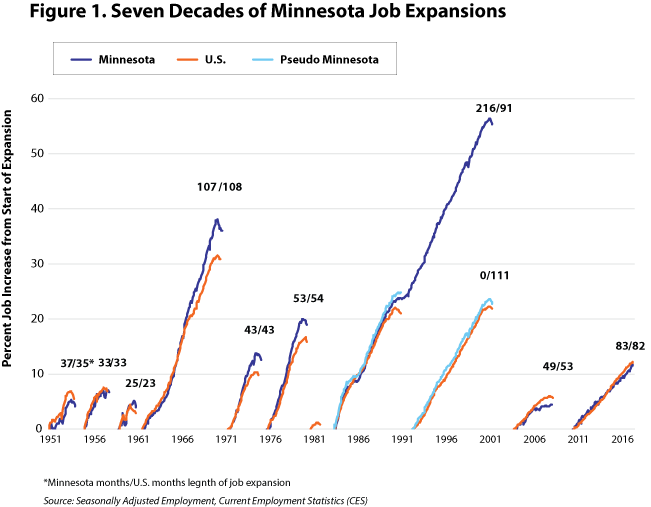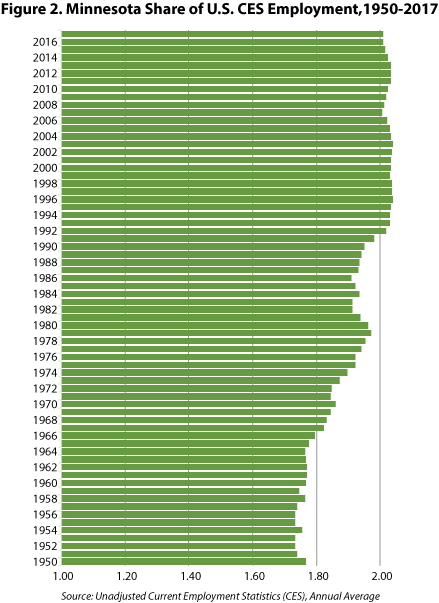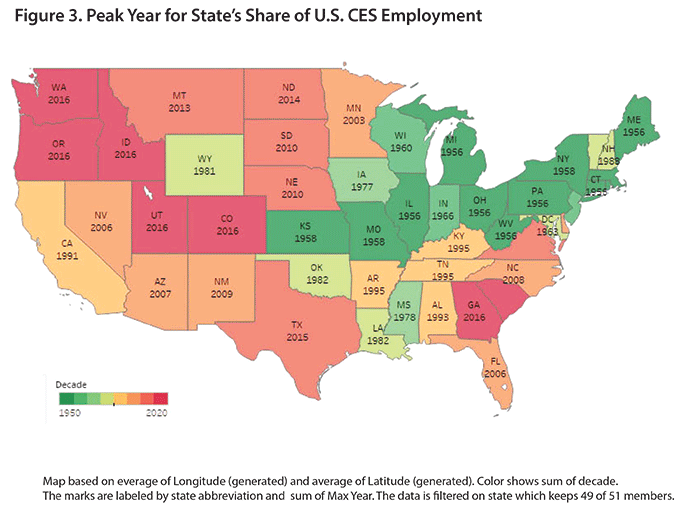by Dave Senf
July 2017
Minnesota’s current job expansion which kicked off in October 2010 as the U.S. economy slowly started to rebound from the Great Recession was 83 months old as of June making this job expansion the third longest in Minnesota dating back to 1950.1 The current expansion will pass the second longest expansion (107 months) in June 2019 barring any economic setback. If this expansion does motor on for another two years the big difference between the 1960s and 2010s expansions will be pace of job growth. Minnesota employment expanded by nearly 40 percent during the 1960s or roughly 3.5 percent annually. Job growth during the current expansion is averaging only 1.6 annually or less than half the pace of 1960s job growth.
Much of the faster job growth during the 1960s can be attributed to the entrance of the baby boom generation into the labor force while the slower growth during the current expansion can be attributed in part to the labor force exit of baby boomers. The odds of this expansion eventually becoming the longest on record are slim, however, as the longest job expansion in Minnesota lasted 216 months or 18 years between 1983 and 2001. That is nearly two and a half times longer than the current expansion which is now seven years in duration.
While Minnesota’s job growth slowed during the 1990-91 recession it never went negative year over year like U.S. wage and salary employment did for 15 months in 1991 and 1992. Minnesota was one of 18 states, including all four of our neighboring states, which recorded no monthly year-over-year job loss during the 1990-92 period. Year-over-year job growth tailed off in most of these states but continued to be higher than a year earlier every month. Minnesota’s nine job expansions since 1950 are compared to U.S. job expansions in Figure 1. The steeper an expansion’s job growth line the faster the job growth over the expansion. Minnesota’s 216-month expansion is shown but is also divided into two pseudo expansions in order to make comparison between Minnesota and national expansions easier.

The bottom axis keeps track of when each of the job expansions started and ended while the left axis measures the percent increase in wage and salary employment from the start to the end of each expansion. Minnesota’s current job expansion is 83 months long as of June which is one month longer than nationally. Wage and salary employment in the state is up 11.6 percent during the last seven years which is slightly below the 12.3 percent U.S. gain. The current expansion, while mild compared to the 1983 – 2001 job boom is almost twice as long as the mid-2000s expansion and twice as robust in terms of percent gain in jobs (83 months to 49 months and 11.6 to 4.5 percent job increase). Minnesota, over the last seven years, has added jobs at a 50 percent faster rate than during the weak 2004-07 job expansion.
The first two job expansions in Minnesota during the 1950s were slightly weaker when compared to national job growth, but over the next five job expansions Minnesota outperformed national employment growth. That count excludes the period between the double dip recessions of the early 1980s when Minnesota wage and salary employment managed to be positive year over year for only three months in 1981 while U.S. employment was positive for 14 months during the 1981-82 period before plunging when the 1982-83 recession took hold. Minnesota’s worst job expansion relative to the nation’s was the weak job growth following the 2001 recession when job growth in the state lagged behind the nation from 2004 to 2007.
Minnesota job expansions, as shown in Figure 1, are highly correlated with U.S. job expansions which holds true for most states to varying degrees. Minnesota’s job growth correlation with U.S. job growth is stronger than most states. The state’s correlation ranks third highest, behind Ohio and Missouri between 1961 and 2017.2 Wage and salary employment in the energy and agricultural dependent states of Alaska, North Dakota, and Wyoming have the lowest correlation with U.S. wage and salary employment.
Figure 1 shows the expansion side of job growth over the last seven decades and skips over periods when job loss on a year-over-year basis occurred. Minnesota job loss during downturns are on average slightly lower than national jobs loss. The double dip recessions of the early 1980s was an exception when job loss in Minnesota was significantly worse than U.S. job decline. As a consequence Minnesota’s share of U.S. wage and salary employment which had been increasing during the 1960s and 1970s dipped noticeably in the early 1980s before rebounding and then surging between 1988 and 1993 as shown in Figure 2.

Minnesota’s peak share of U.S. wage and salary employment was reached in 2003 at 2.04 percent. Over the last 14 years the state share has slipped slightly standing at 2.01 percent through the first half of 2017.3 The tiny 0.03 percentage point drop off from peak share translates into roughly 45,000 jobs meaning that wage and salary employment in the state in June would have been 43,000 higher or 1.5 percent more than the June’s estimate had Minnesota’s share of U.S. employment remained at the 2.04 percent peak achieved in 2003.
Will the 2003 peak share end up being as good as it ever gets for Minnesota when it comes to the state’s share of U.S. employment? Figure 3, which displays the year each state reached their peak share of U.S. wage and salary employment, suggests probably if Minnesota’s relative job growth follows the pattern established by most states east of the Mississippi River.4 Nine states either reached or had already experienced their peak year when the data start in 1956. Those states include the populous states of Illinois, Ohio, Pennsylvania, and Massachusetts. New York peaked in 1958 with 11.7 percent of all U.S wage and salary employment. Last year the Empire State’s share was down to 6.5 percent.

Only seven states recorded peak shares last year - Colorado, Georgia, Idaho, Oregon, South Carolina, Utah, and Washington. These states will likely continue to record peak share years in coming years as their job growth seems likely to continue to outpace U.S. job growth.
Other states like Arizona, Florida, Nevada, and Texas are sure bets eventually to record higher shares of U.S. employment in the future thanks in large part to the Baby Boomers fleeing winter up North and retiring to warmer climates. Arizona, Florida, and Nevada were ground zero of the housing bust and are still recovering. The peak year for Texas is currently 2015, reflecting slower job growth in 2015 from the fallout from waning oil prices. Texas will undoubtedly surpass its 2015 peak job share within a year or two.
Minnesota’s share of U.S. employment is less certain than the states above. The state’s employment share may gradually decline over the years like Wisconsin which reached peak share back in 1960 (think Happy Days TV show). Or perhaps it will stage another comeback like the state did in the 1990s. Our North Dakota neighbors took 28 years to top its 1982 peak employment share in 2010. All it took in North Dakota was a once in a lifetime oil boom.5
1Job expansion is defined here as a year or more of uninterrupted monthly year-over-year positive employment change. Employment is measured by monthly seasonally adjusted Current Employment Statistics (CES) data. CES employment estimates cover non-agriculture wage and salary employment. The unadjusted data are available at Current Employment Statistics and State and Metro Area Employment, Hours, & Earnings.
2Correlation coefficients were based on unadjusted monthly CES percent change from January 1961 to May 2017.
3Minnesota’s CES over-the-year growth through June 2017 is averaging 1.7 percent which is slightly above the national average of 1.5 percent. CES data, however, are benchmarked annually against Quarterly Census of Employment and Wage (QCEW) data in March of the following year both for the state and nation. The benchmark can change earlier estimates.
4Hawaii and Alaska are not shown on the map but reached peak share in 1992 and 2011 respectively..
5Each state’s CES employment along with state share of U.S. CES employment from 1956 through 2016.